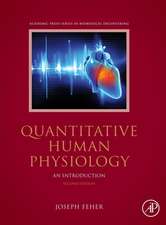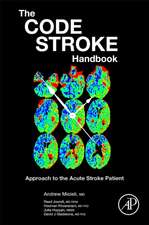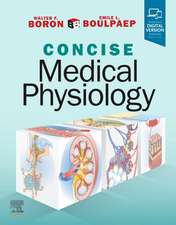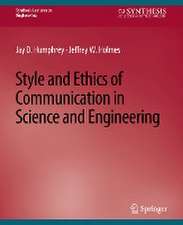An Introduction to Biomechanics: Solids and Fluids, Analysis and Design
Autor Jay D. Humphrey, Sherry L. O’Rourkeen Limba Engleză Paperback – 18 oct 2016
| Toate formatele și edițiile | Preț | Express |
|---|---|---|
| Paperback (1) | 675.69 lei 6-8 săpt. | |
| Springer – 18 oct 2016 | 675.69 lei 6-8 săpt. | |
| Hardback (1) | 872.43 lei 3-5 săpt. | |
| Springer – 28 iul 2015 | 872.43 lei 3-5 săpt. |
Preț: 675.69 lei
Preț vechi: 711.25 lei
-5% Nou
Puncte Express: 1014
Preț estimativ în valută:
129.31€ • 140.41$ • 108.62£
129.31€ • 140.41$ • 108.62£
Carte tipărită la comandă
Livrare economică 22 aprilie-06 mai
Preluare comenzi: 021 569.72.76
Specificații
ISBN-13: 9781493938315
ISBN-10: 1493938312
Pagini: 718
Ilustrații: XXVI, 692 p. 298 illus.
Dimensiuni: 155 x 235 x 37 mm
Greutate: 0.99 kg
Ediția:Softcover reprint of the original 2nd ed. 2015
Editura: Springer
Colecția Springer
Locul publicării:New York, NY, United States
ISBN-10: 1493938312
Pagini: 718
Ilustrații: XXVI, 692 p. 298 illus.
Dimensiuni: 155 x 235 x 37 mm
Greutate: 0.99 kg
Ediția:Softcover reprint of the original 2nd ed. 2015
Editura: Springer
Colecția Springer
Locul publicării:New York, NY, United States
Cuprins
1 Introduction.-2 Stress, Strain, and Constitutive Relations.- 3 Equilibrium, Universal Solutions, and Inflation.- 4 Extension and Torsion.- 5 Beam Bending and Column Buckling.- 6 Some Nonlinear Problems.- 7 Stress, Motion, and Constitutive Relations.-8 Fundamental Balance Relations.-9 Some Exact Solutions.-10 Control Volume and Semi-empirical Method.-11 Coupled Solid–fluid Problems.-12 Epilogue
Notă biografică
Jay D. Humphrey is a John C. Malone Professor of Biomedical Engineering at Yale University. He received the Ph.D. degree in Engineering Science and Mechanics from The Georgia Institute of Technology and completed a post-doctoral fellowship in Cardiovascular Research at The Johns Hopkins University. He has authored a book titled Cardiovascular Solid Mechanics: Cells, Tissues, and Organs, co-authored a book titled Style and Ethics of Communication in Science and Engineering, co-edited a book titled Cardiovascular Soft Tissue Mechanics, and authored or co-authored chapters for over 20 other books or encyclopedias as well as over 200 archival technical papers. He served as founding co-Editor In Chief for the international journal Biomechanics and Modeling in Mechanobiology and has served as Associate Editor for five other technical journals. He is a Fellow of the American Society of Mechanical Engineers (Bioengineering Division) and the American Institute of Medical and Biological Engineers.
Sherry L. O’Rourke is a Technical Field Engineer at Medtronic Inc. in the Cardiac Rhythm Disease Management Division. She received the B.S. and M.S. degrees in Biomedical Engineering from Texas A&M University and co-authored an archival paper on the biomechanics of the lens capsule of the eye, which is important in understanding device design for cataract surgery. Since graduation she has spent her professional life dedicated to designing, developing, and teaching programs to help physicians, residents, and nurses ensure that patients receive the maximum benefit from pacemakers and implantable defibrillators that are designed for those suffering from chronic heart disease.
Sherry L. O’Rourke is a Technical Field Engineer at Medtronic Inc. in the Cardiac Rhythm Disease Management Division. She received the B.S. and M.S. degrees in Biomedical Engineering from Texas A&M University and co-authored an archival paper on the biomechanics of the lens capsule of the eye, which is important in understanding device design for cataract surgery. Since graduation she has spent her professional life dedicated to designing, developing, and teaching programs to help physicians, residents, and nurses ensure that patients receive the maximum benefit from pacemakers and implantable defibrillators that are designed for those suffering from chronic heart disease.
Textul de pe ultima copertă
This textbook introduces the student to a consistent approach of formulating and solving problems involving the biomechanics of solids and fluids. Brief introductions are also provided for more complex situations that require methods of nonlinear elasticity, viscoelasticity, elastodynamics, or fluid-solid interactions. Concepts are motivated by concise descriptions of important biological, mechanical, and clinical observations and techniques. Over 300 figures are included, as well as complete derivations of the fundamental equations, solutions of over 80 example problems, and over 300 exercise problems.
Perfect for a one- or two-semester introduction to biomechanics, this Second Edition includes updated content in the form of new motivational observations, examples, appendices, exercises, and references. An Introduction to Biomechanics, Second Edition is an ideal book for undergraduate students with interests in bioengineering, biomedical engineering, or biomechanical engineering, and also serves as a valuable reference for graduate students, practicing engineers, and researchers.
This book also:
· Guides students in developing intuitive understanding via a consistent consideration of a variety of problems including cardiovascular, musculoskeletal, pulmonary, and cell mechanics
· Enco
urages students to develop a “big-picture” approach to problem-solving in biomechanics through new chapter summaries
· Challenges students to solve problems under common conditions experienced in the laboratory or clinic
Perfect for a one- or two-semester introduction to biomechanics, this Second Edition includes updated content in the form of new motivational observations, examples, appendices, exercises, and references. An Introduction to Biomechanics, Second Edition is an ideal book for undergraduate students with interests in bioengineering, biomedical engineering, or biomechanical engineering, and also serves as a valuable reference for graduate students, practicing engineers, and researchers.
This book also:
· Guides students in developing intuitive understanding via a consistent consideration of a variety of problems including cardiovascular, musculoskeletal, pulmonary, and cell mechanics
· Enco
urages students to develop a “big-picture” approach to problem-solving in biomechanics through new chapter summaries
· Challenges students to solve problems under common conditions experienced in the laboratory or clinic
Caracteristici
Follows up to the popular first edition with updated material, exercises and approaches Encourages students to develop an intuitive, “big-picture” approach to biomechanics and problem-solving Focuses on biomechanics from a continuum mechanics perspective Request lecturer material: sn.pub/lecturer-material



























